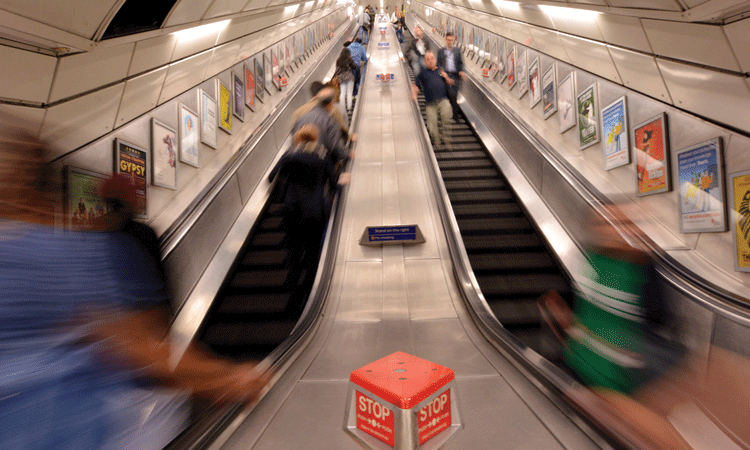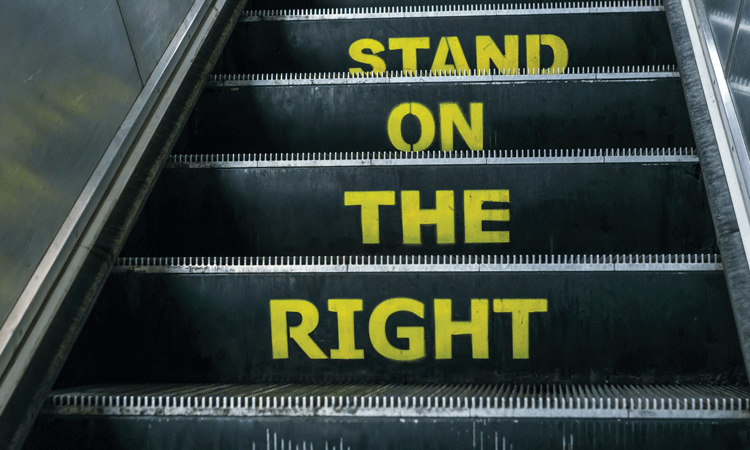LU’s Escalator Passenger Safety Strategy: Making passengers safer
- Like
- Digg
- Del
- Tumblr
- VKontakte
- Buffer
- Love This
- Odnoklassniki
- Meneame
- Blogger
- Amazon
- Yahoo Mail
- Gmail
- AOL
- Newsvine
- HackerNews
- Evernote
- MySpace
- Mail.ru
- Viadeo
- Line
- Comments
- Yummly
- SMS
- Viber
- Telegram
- Subscribe
- Skype
- Facebook Messenger
- Kakao
- LiveJournal
- Yammer
- Edgar
- Fintel
- Mix
- Instapaper
- Copy Link
Posted: 16 December 2016 | Phil Harley (London Underground) | No comments yet
Recent safety data has identified that a large proportion of customer injuries occur when travelling on escalators. The London Underground (LU) has therefore established the Escalator Passenger Safety Strategy (EPSS) Committee to investigate methods to influence passenger behaviour on escalators. Phil Harley, Senior Engineer of the Ops LU Engineering Stations Equipment Team and Chair of the EPSS, explains more in this article.


Safety, reliability and value for money are the foundation of LU’s service. Although our safety record is one of the best in the world we guard against complacency and strive for continuous improvement. Evaluation of company incident data has identified that the largest cause of customer injuries on London Underground is slips, trips and falls with 40% of all injuries reported occurring on escalators.
An escalator is a unique method of passenger transit in that passengers are in direct contact with moving powered machine parts, with minimal guarding between the moving steps on which they stand as well as the static landings or balustrades. The high prevalence of slip/trip/fall incidents on escalators, along with less regular but potentially more serious entrapment incidents, are not due to either asset or operational defects. The vast majority of these accidents – greater than 99% – are found to be directly due to customer behaviour.
In response to this identified risk to passenger safety, the Escalator Passenger Safety Strategy (EPSS) Committee was formed with the intent of developing a solution. The aim of the EPSS is to investigate methods of influencing passenger behaviour on escalators, to encourage their safe use, and to ensure that risks are highlighted to inform customers of their best course of action.


Step riser messaging can encourage a positive change of behaviour
The purpose of the EPSS is to identify effective methods of influencing passengers’ behaviour to increase their safety on escalators. It is not meant to discuss innovations in escalator mechanical safety; this is regarded as ‘business as usual’ and is dealt with elsewhere in the organisation. Due to the high prevalence of injuries on escalators that are not due to mechanical failure, there is a need to inform the passenger either directly or subliminally of safe practices for transiting escalators. This can be broken down into the following four main themes, or mitigating messages:
- Hold the handrail
- Walk/stand safely
- Be aware of the step/landing interface
- Where possible, use lifts when mobility is impaired.
These four core messages were embodied in 12 selected initiatives: technical interventions with the specific purpose of altering passengers’ behaviour either by direct information or subliminal coercive ‘nudges’. The 12 initiatives were subjected to a six month operational trial where they were installed on working escalators to assess their effectiveness.
Some of these initiatives are industry standards (such as over-comb and under-step lighting, and step edge painting) whilst others are novel and untried, (‘e-Toblerone’ video screens, Passenger Positional Guides and step riser messaging, for example). The reason for inclusion of known systems as well as new concepts in the trial is straightforward: there appears to be very little in the way of independent assessment of their effectiveness in encouraging safe behaviours. Therefore, as part of the trial we needed to determine the effectiveness of both established and new methods for altering customer behaviour.
In order to have the greatest benefit, effort was directed at the ‘Top 20’ assets where the highest occurrence of incidents and accidents has been previously recorded. This Measurement of Effectiveness (MoE) was conducted in the following four ways:
- By statistical comparison of accidents on escalators before and after installation of initiatives, over a six month period for each trial location
- A survey of passenger behaviours to accurately judge the effect of the initiatives was conducted in two ways: collection of CCTV data from before installation; directly after installation; and following three months deployment. Where insufficient image quality was available from CCTV we temporarily installed GoPro cameras to record at the same periodicity
- The technical effectiveness of the initiatives was examined (robustness, wear, impact on maintenance etc.) along with their impact on the stations’ environments
- A survey of station staff to give further depth to the analysis by gaining their subjective insight into the effect on passengers’ behaviour over the length of the trial.
The trial ran from 15 September 2015 to 16 March 2016 inclusive. Following completion of the six month trial results were collected and reviewed against the MoEs aforementioned. Validation of our methodology was conducted by the independent LU Customer Insight Team. The following seven initiatives were judged to be effective, measured against achieving a greater than 10% change in behaviour or reduction in accidents and a positive result on three of the four MoEs:
Passenger Positional Guides (PPGs)
Blue bi-directional foot prints to encourage safe foot placement achieved a 21% positive change of behaviour.
Red Lexan Combs
Red polycarbonate comb sections to highlight the step/landing interface achieved a 15.9% positive change of behaviour.
Pattress video screens (e-Toblerones)
Bi-directional pattress TV screens displaying safety messages achieved an 11.2% positive change of behaviour.
Virtual Assistant Projector (Holo)
Silhouette projector imparting verbal safety messages achieved a 19.9% positive change of behaviour.
Step Riser Messaging
Safety messages stencilled on non-cleated step risers achieved an 11.4% positive change of behaviour.
Message Handrails
Safety messages embedded in the handrail achieved a 17.4% positive change of behaviour.
Lift Floor Vinyls
Vinyl floor signage to indicate locations of lifts achieved only a 1% change of behaviour – however, other factors including siting as ‘breadcrumb’ guides from ticket lines; Wide Access Gates; enhanced visibility and passenger compliance behaviour improvement; along with very positive feedback from station staff (use as reference points etc.) meant that they were deemed to be successful.
Of equal value to knowing what does work is knowing which initiatives didn’t work, to prevent wasted effort and funds installing them in the future. The following five initiatives were judged to be unsuccessful:
Under step lighting
An industry standard optional installation which shines light from beneath the moving steps to highlight the changing step band geometry, or the approach to the landing, was found to only provide 0.08% positive change of behaviour.
Over comb lighting
An industry standard optional installation which shines light directly on the landing comb to highlight the step-to-landing interface provided only a 2.1% positive change of behaviour.
Step Edge Painting
An industry standard optional installation to denote the edge of steps achieved only a 2% positive change of behaviour.
Escalator floor vinyls
These were very similar to lift vinyls placed at the escalator entrances to encourage holding the handrail and achieved only a 7.6% positive change of behaviour.
Directional speakers and PA messages
These were hoped to encourage safe behaviour but were unsuccessful due to operational and installation issues.
A report was produced on 1 April 20161, the recommendations of which were ratified by the London Underground Customer Safety Steering Group, with authorisation to roll-out successful initiatives to high risk sites. Stakeholder agreement on the installation plan has been achieved across the ‘Top 10’ stations and funding has been agreed for installation of six out of the seven successful initiatives (‘e-Toblerones’ were dropped due to high unit costs but will be revisited with an option of external sponsorship). Finally, the EPSS Committee has been permanently established to act as a clearing house and assessor of any future escalator safety suggestions.
In development of the EPSS we have sought involvement from a wide array of external organisations including the Community of Metros (CoMET – the international forum for metropolitan rail transport providers); the Construction Industry Research & Information Agency (CIRIA); Health & Safety Laboratories (HSL – an agency of the Health & Safety Executive); and the Office of Rail & Road (ORR), along with a number of manufacturers and suppliers.
Conclusion
The EPSS has established for LU which interventions significantly affect passenger behaviour, and which do not. Over the 13 stations on which the initiatives were installed, the overall accident rate decreased by 3%, which considering the initiatives were only installed on 15% of those sites’ escalators is a significant drop. In effect, LU now has a catalogue of interventions that are known to improve passenger safety, which can be selected to match the bespoke requirements of individual stations, and can provide a reduction in passenger accidents of up to 20%.
Reference
- Available on open source via SPARK


Related topics
Infrastructure & Urban Planning, Passenger Accessibility, Passenger Experience, Transport Governance & Policy, Vehicle & Passenger Safety
Issue
Issue 6 2016
Related organisations
London Underground








